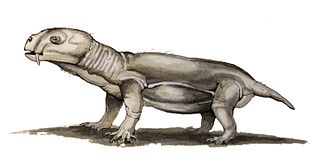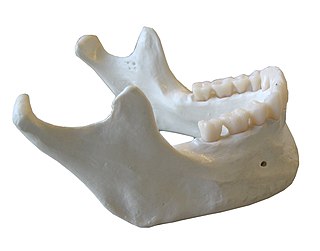
The maxilla in vertebrates is the upper fixed bone of the jaw formed from the fusion of two maxillary bones. In humans, the upper jaw includes the hard palate in the front of the mouth. The two maxillary bones are fused at the intermaxillary suture, forming the anterior nasal spine. This is similar to the mandible, which is also a fusion of two mandibular bones at the mandibular symphysis. The mandible is the movable part of the jaw.

In human anatomy, the facial skeleton of the skull the external surface of the mandible is marked in the median line by a faint ridge, indicating the mandibular symphysis or line of junction where the two lateral halves of the mandible typically fuse at an early period of life. It is not a true symphysis as there is no cartilage between the two sides of the mandible.

The chin is the forward pointed part of the anterior mandible below the lower lip. A fully developed human skull has a chin of between 0.7 cm and 1.1 cm.

Janjucetus is an extinct genus of cetacean, and a basal baleen whale (Mysticeti), from the Late Oligocene around 25 million years ago (mya) off southeast Australia, containing one species J. hunderi. Unlike modern mysticetes, it possessed large teeth for gripping and shredding prey, and lacked baleen, and so was likely to have been a predator that captured large single prey animals rather than filter feeding. However, its teeth may have interlocked, much like those of the modern-day filter-feeding crabeater seal, which would have allowed some filter-feeding behavior. Its hunting behaviour was probably similar to the modern-day leopard seal, probably eating large fish. Like baleen whales, Janjucetus could not echolocate; however, it did have unusually large eyes, and so probably had an acute sense of vision. The only specimen was found on the Jan Juc beach, where the remains of the extinct whales Mammalodon, Prosqualodon and Waipatia have also been discovered.

Pliosaurus is an extinct genus of thalassophonean pliosaurid known from the Kimmeridgian and Tithonian stages of Europe and South America. Their diet would have included fish, cephalopods, and marine reptiles. This genus has contained many species in the past but recent reviews found only six to be valid, while the validity of two additional species awaits a petition to the International Code of Zoological Nomenclature. Currently, P. brachyspondylus and P. macromerus are considered dubious, while P. portentificus is considered undiagnostic. Most species of Pliosaurus reached 8 metres (26 ft) in length and 5 metric tons in body mass, while P. rossicus and P. funkei may have reached or even exceeded 10 metres (33 ft) in length and 11 metric tons in body mass, being the largest plesiosaurs of all time. Species of this genus are differentiated from other pliosaurids based on seven autapomorphies, including teeth that are triangular in cross section.
Mammalodon is an extinct genus of archaic baleen whale belonging to the family Mammalodontidae.

Aetiocetus is a genus of extinct basal mysticete, or baleen whale that lived 33.9 to 23.03 million years ago, in the Oligocene in the North Pacific ocean, around Japan, Mexico, and Oregon, U.S. It was first described by Douglas Emlong in 1966 and currently contains known four species, A. cotylalveus, A. polydentatus, A. tomitai, and A. weltoni. These whales are remarkable for their retention of teeth and presence of nutrient foramina, indicating that they possessed baleen. Thus, Aetiocetus represents the transition from teeth to baleen in Oligocene mysticetes. Baleen is a highly derived character, or synapomorphy, of mysticetes, and is a keratinous structure that grows from the palate, or roof of the mouth, of the whale. The presence of baleen is inferred from the fossil record in the skull of Aetiocetus. Aetiocetus is known from both sides of the Pacific Ocean: it was first documented in Oregon, United States, but it is also known from Japan and Mexico. The genus is currently constrained to the Northern hemisphere and has little value in biostratigraphic studies of the Oligocene due to its limited occurrences across the Pacific.

Eosimops is an extinct genus of pylaecephalid dicynodonts. They were small synapsids superficially resembling modern mammals. Eosimops is known from several skull specimens, as well as one complete skeleton. Eosimops lived during the Middle Permian of South Africa.
Ancalecetus is an extinct genus of early whale known from the Late Eocene Birket Qarun Formation in Wadi Al-Hitan, Egypt. The species is named after anthropologist and primate researcher Elwyn L. Simons who discovered the type specimen in 1985.

In anatomy, the mandible, lower jaw or jawbone is the largest, strongest and lowest bone in the human facial skeleton. It forms the lower jaw and holds the lower teeth in place. The mandible sits beneath the maxilla. It is the only movable bone of the skull. It is connected to the temporal bones by the temporomandibular joints.

Llanocetus is a genus of extinct toothed baleen whales from the Late Eocene of Antarctica. The type species, Llanocetus denticrenatus, reached gigantic proportions, with the juvenile specimen reaching an estimated 8 m (26 ft) in length; a second, unnamed species, known only from three isolated premolar teeth, reached an estimated total body length of up to 12 m (39 ft). Like other contemporary baleen whales of the Eocene, Llanocetus completely lacked baleen in its jaws. It was probably a suction feeder like the modern beaked and pygmy right whales.

Astorgosuchus is an extinct monospecific genus of crocodilian, closely related to true crocodiles, that lived in Pakistan during the late Oligocene period. This crocodile may have reached lengths of up to 8 m (26 ft) and is known to have preyed on many of the large mammals found in its environment. Bite marks of a large crocodile have been found on the bones of juvenile Paraceratherium, however if these were left by Astorgosuchus cannot be said with certainty. The genus contains a single species, Astorgosuchus bugtiensis, which was originally named as a species of Crocodylus in 1908 and was moved to its own genus in 2019.

Waharoa is a genus of eomysticetid baleen whale from the Late Oligocene (Chattian) of New Zealand. It was identified with the discovery of Waharoa ruwhenua by Boessenecker and Fordyce (2015), which added a new genus and species to a monophyletic family Eomysticetidae.
Allodelphinidae is a family of primitive platanistoid river dolphins found in marine deposits in the eastern North Pacific region, Alaska, and Japan.

Cricodon is an extinct genus of trirachodontid cynodonts that lived during the Early Triassic and Middle Triassic periods of Africa. A. W. Crompton named Cricodon based on the ring-like arrangement of the cuspules on the crown of a typical postcanine tooth. The epithet of the type species, C. metabolus, indicates the change in structure of certain postcanines resulting from replacement.

Coronodon is a genus of toothed mysticetes from the Early Oligocene Ashley Formation of South Carolina.

Arisierpeton is an extinct genus of synapsids from the Early Permian Garber Formation of Richards Spur, Oklahoma. It contains a single species, Arisierpeton simplex.
Syntomiprosopus is an extinct genus of archosauriform, possibly a crocodylomorph from the Late Triassic period of Arizona. The type and only known species is S. sucherorum. Syntomiprosopus was unusually short-snouted, comparable to the Late Cretaceous notosuchian Simosuchus, and is regarded as an example of convergent evolution between Triassic stem-archosaurs and Cretaceous archosaurs.
Ultrastenos is an extinct genus of Australian mekosuchine crocodilian first described in 2016. The type species Ultrastenos willisi was discovered at Riversleigh in northwestern Queensland, Australia, and lived during the Late Oligocene era.

Kyhytysuka is an extinct genus of ophthalmosaurian ichthyosaur from Early Cretaceous Colombia. The animal was previously assigned to the genus Platypterygius, but given its own genus in 2021. Kyhytysuka was a mid-sized ophthalmosaurian with heterodont dentition and several adaptations suggesting that it was a macropredatory vertebrate hunter living in shallow waters. It contains a single species, Kyhytysuka sachicarum.















